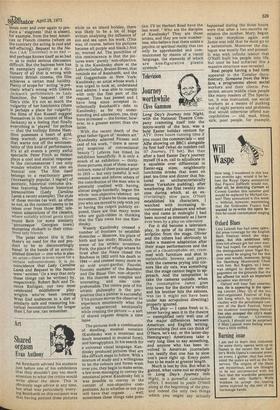Art
Shared orgasm
Evan Anthony .
Ad Reinhardt advised his students Just before one of his exhibitions that they shouldn't pay too much attention to what the critics would Write about the show. This is Obviously sage advice at any time, but what was particularly worrying Reinhardt on this occasion was that having painted these pictures while on an island holiday, there was likely to be a lot of bilge written analysing the influence of sun and sea upon his work. (This was, of course, before his pictures became all purple and black.) Not so, warned Ad. The punchline of this reminiscence is that the pictures were ' purely' non-objective. It is the Kandinsky show at the Lefevre Gallery, Bruton Street, that reminds me of Reinhardt, and the old Guggenheim in New York: Kandinsky, an artist whose work I was urged to look at, understand and admire. I was able to comply with only the first part of the request. Time has passed and I have long since accepted intellectually Reinhardt's debt to Kandinsky; as for my understanding and admiration, yes, they have increased — the former, however, to a greater extent than the latter.
With the recent death of the great father figure of' modern art ' (Kandinsky admired Picasso and said of his work, "there is never any suspicion of conventional beauty ") Lefevre has timed its exhibition beautifully. It is only a snack of an exhibition — thirtythree pictures, most of them watercolours, none of them painted prior to 1915 — but very tasteful. It will remind some and inform others of the contribution of the man who is generally credited with having, almost single-handedly, begun the whole non-objective/abstract art movement. If there be those among you who are moved to yelp with joy at having the culprit publicly exposed, there are that many more who are guilt-ridden in thinking that the Tate owns but one Kandinsky. Wassily Kandinsky crossed a number of frontiers to establish domiciles — Moscow, his place of birth and law study; Munich, the scene of his artistic invention; Paris, the place of refuge where he lived after the Nazis closed the Bauhaus in 1932 until his death in 1944 — and crossed many more as an avid avant-gardist, Fauvist, founder member of the Bauhaus and Die Blaue Vier, non-objectivist. His theories are complex and interesting, and also com prehensible. The centre pole of his artistic philosophy is the pro position that a painter is successful if his picture moves the observer to experience emotionally what the artist experienced emotionally while creating the picture — a sort of shared orgasm despite a time lapse.
The pictures look a combination of doodling, musical notation (Kandinsky was a musician and much interested in musical form), and hieroglyphics. In his search for a universal visual language, Kandinsky produced pictures that are like difficult maps to follow. With a mixture of study and a willingness to let the colours and forms wash over you, they begin to make sense, a few even managing to convey the emotional power Kandinsky felt it was possible to convey in the context of non-objective com• positions. As to whether or not you will have that orgasm . . . well, sometimes these things take prac
tice. I'll let Herbert Read have the last word: " Who are the disciples of Kandinsky? They are those artists, and they are now numberless, who believe that there exists a psychic or spiritual reality that can only be apprehended and cornmunicated by means of a visual language, the elements of which are non-figurative plastic symbols."


































 Previous page
Previous page